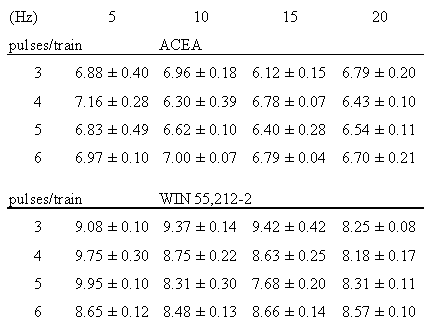| pA2
online © Copyright 2003 The British Pharmacological Society |
043P
University
of Manchester Autumn Meeting September 2003 |
|
Effect of
electrical field stimulation parameters on the potency of two cannabinoid
agonists in the mouse vas deferens
|
Print Abstract Search PubMed
for: |
Electrical field stimulation of the mouse isolated vas deferens is a well-established assay for the study of cannabinoid agonists (Pertwee et al., 1995). Stimulation of pre-synaptic CB1 receptors results in a reduction in neurotransmitter release and subsequent contractions. The aim of this study was to investigate the effect of number of pulses per train and frequency on the potency of two chemically different CB1 agonists (Arachidonyl-2'-chloroethylamide (ACEA) and WIN 55,212-2) in the mouse vas deferens.
ICR mice (25-30g) were killed by exposure to CO2. Each vas deferens was removed, cleaned, secured with sutures and placed in a 10ml tissue bath containing Mg2+-free modified Krebs-Henseleit buffer at 37°C and bubbled with 95% O2 and 5% CO2. The sutures were connected to a tissue holder and a Grass isometric force transducer which was then connected to an amplifier and recorder. Each vas deferens was subjected to constant current electrical field stimulation via two platinum electrodes, using a D330 MultiStim stimulator. Stimulation parameters were: constant current of 400mA, pulses of 2msec duration and 0.1min intervals between trains. After 45 min, a cumulative concentration response curve (CCRC) was started (Range: 10-10 - 10-5M; 0.5 log unit increments; 3 min intervals). Four different number of pulses per train and four different frequencies (Hz) were used in these experiments (Table 1).
Table 1 Mean pEC50 values for ACEA and WIN 55,212-2 in the MVD.

Data are expressed as Mean and SEM, n = 4 - 6 / group.
These results demonstrate that small changes in stimulation parameters cause changes in the sensitivity of the tissue to the agonists. This indicates that comparison of results from different laboratories is difficult when different stimulation conditions are used.
Pertwee R.G. et al., (1995) Eur. J. Pharmacol., 248: 241-247.